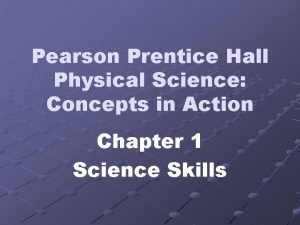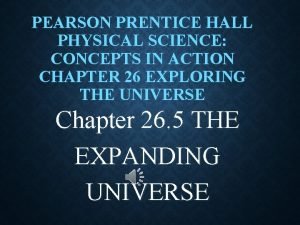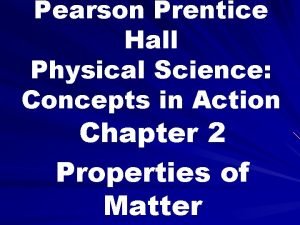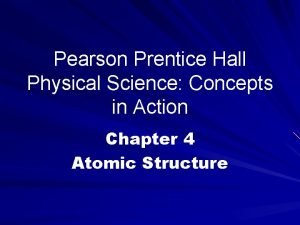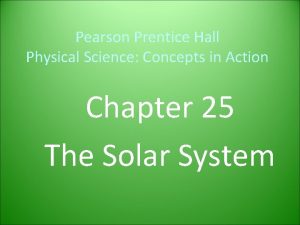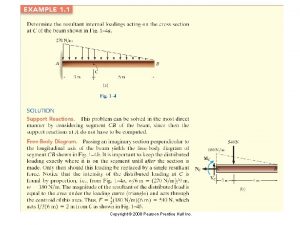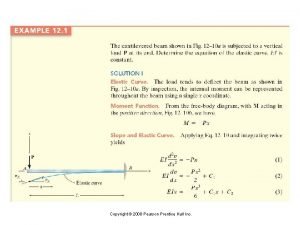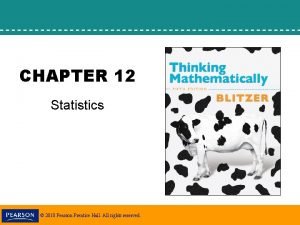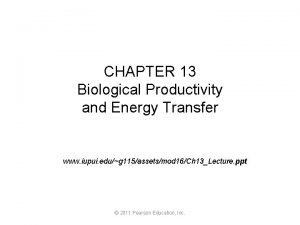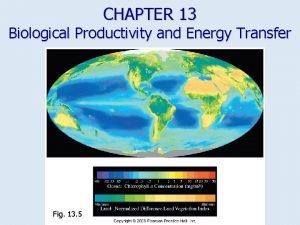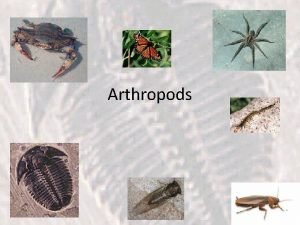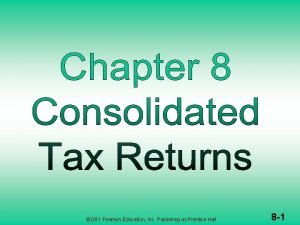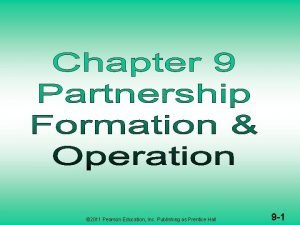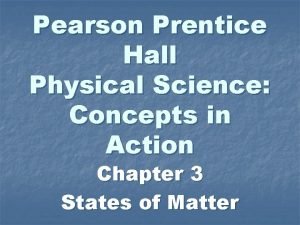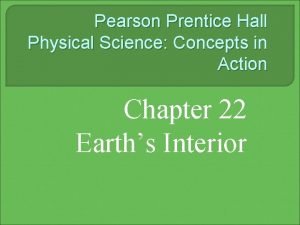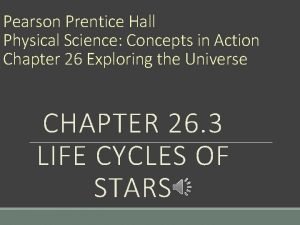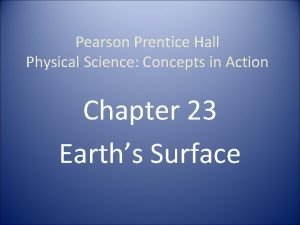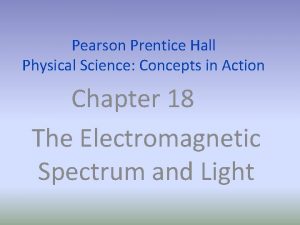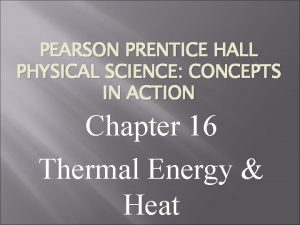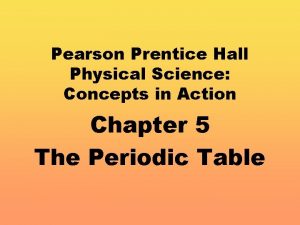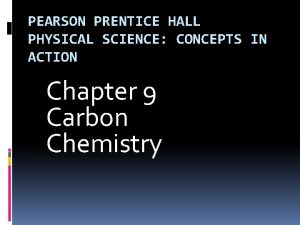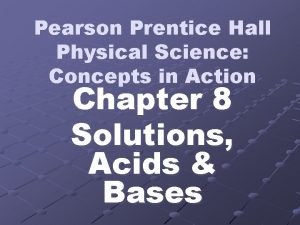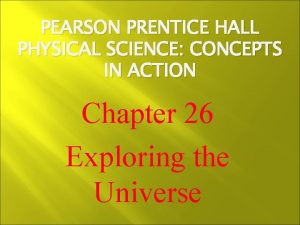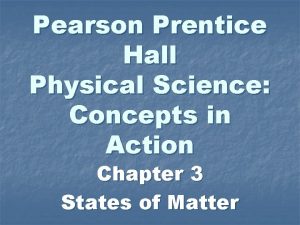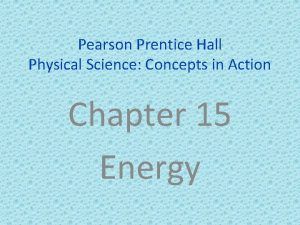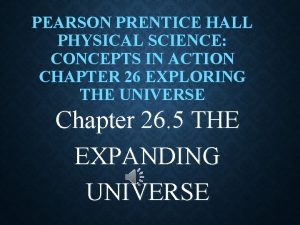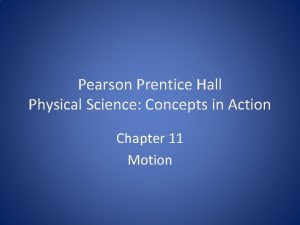Pearson Prentice Hall Physical Science Concepts in Action





















- Slides: 21

Pearson Prentice Hall Physical Science: Concepts in Action Chapter 6 Chemical Bonds

6. 1 Ionic Bonding • Objectives: • 1. Explain when an atom is unlikely to react • 2. Indicate one way in which elements can achieve a stable electron configuration • 3. Express how the structure of an ionic compound affects its properties

When Atoms are Unlikely to React • When the highest occupied energy level (the outer shell) is filled with electrons (valence electrons), the atom is stable and unlikely to react • The valence electrons can be represented by a special drawing called an electron dot diagram

Achieving Stable Electron Configurations • Atoms can become stable by filling their outer shells with electrons • Some elements achieve stable electron configurations by transferring electrons between atoms • The gain or loss of electrons between the atoms then produces full shells & stability

• The gain or loss of electrons also produces an atom with a net positive charge (lost one or more electrons) or a net negative charge (gained one or more electrons) • Definition: an ion is an atom with a net positive or net negative charge • Definition: an anion is an ion with a net negative charge • Definition: a cation is an ion with a net positive charge

• Definition: a chemical bond is the force that holds atoms or ions together as a unit • Definition: an ionic bond is the force that holds cations and anions together • Definition: an ionic bond is the bond that forms when electrons are transferred from one atom to another • Definition: a chemical formula is a notation that shows which elements a compound contains & the ratio of atoms or ions of the elements that make up the compound

• Cations form when electrons gain enough energy to escape from atoms • Electrons must overcome the natural attraction to the protons in the nucleus • Definition: ionization energy is the amount of energy used to remove an electron from an atom • The lower the ionization energy is, the easier it is to remove an electron • Ionization generally increases in the periodic table from left to right and

Structure and Properties • Many ionic compounds are solid at room temperature • IONIC COMPOUNDS GENERALLY CONSIST OF A METAL + A NONMETAL • Their molecular structure has an orderly repeating three dimensional structure called a lattice • Definition: solids whose particles are arrange in a lattice are called crystals • The properties of an ionic compound can be explained by the strong attractions among the ions in a crystal lattice

6. 2 Covalent Bonding • Objectives: • 1. Explain how atoms are held together in a covalent bond • 2. Describe what happens when atoms don’t share electrons equally • 3. Discuss what factors determine whether a molecule is polar • 4. Compare the attractions between polar molecules with the attractions between nonpolar molecules

How Atoms Are Held Together in a Covalent Bond • Definition: a covalent bond is a chemical bond in which two atoms share a pair of valence electrons • Definition: a molecule is a neutral group of atoms that are joined together by one or more covalent bonds • The attractions between the shared electrons & the protons in each nucleus hold the atoms together in a covalent bond • It is possible for more than one pair of electrons to be shared producing a double or triple covalent bond

Polar Attractions • Attractions between polar molecules are stronger than attractions between nonpolar molecules • “Like attracts like”: polar molecules are attracted to polar molecules while nonpolar molecules are attracted to nonpolar molecules • Q: What does the subscript 2 in the formula for the hydrogen molecule (H 2) mean?

Unequal Sharing of Electrons • IN GENRAL, COVALENT MOLECULES CONSIST OF TWO NONMETALS • Definition: a polar covalent bond is a covalent bond in which the electrons are not shared equally • When atoms form a polar covalent bond, the atom with the greater attraction for electrons has a partial negative charge (written δ-) • The other atom has a partial positive charge (written δ+) • Water is an example

Factors that Determine Polarity • The type of atoms in a molecule and its geometric shape are factors that determine whether a molecule is polar or nonpolar • Example: CO 2 is linear, while the water molecule is bent

6. 3 Naming Compounds & Writing Formulas • Objectives: • 1. Explain what information the name and formula of an ionic compound provide • 2. Describe the information that the name and formula of a molecular compound provide

Ionic Compound Formulas • The name of an ionic compound (usually a metal plus a nonmetal) must distinguish the compound from other ionic compounds containing the same elements • The formula of an ionic compound describes the ratio of the ions in the compound

• Definition: a binary compound is a compound made of only 2 elements • The name of a binary compound follows a pattern • The cation (+ charge, usually the metal) is named first followed by the anion (- charge, usually the nonmetal) • The cation states its name • There is a special suffix for the anion • The anion uses the stem of its name plus –ide ex: chlorine becomes chloride (-ide means it’s an ion)

• Many transition metals can form more than one ion • Ex: iron can be Fe 2+ or Fe 3+ & is called “iron two ion” or “iron three ion” • The name of transition metal ions will have a Roman numeral after the name that states the charge • Ex: Cu. O is copper(II) oxide because copper can be Cu+ or Cu 2+ • Definition: a polyatomic ion is a covalently bonded group of atoms acting as a single unit that carries a charge • Compounds with polyatomic ions are ionic compounds

• If you know the name, you can write the formula • The total charges of the cations and anions must add up to zero • Sodium ion is Na+ while sulfide is S 2 • You will need 2 sodium ions to make the charges add up to zero • It is written Na 2 S and is called sodium sulfide

Molecular Compound Formulas • The name and formula of a molecular compound describe the type and number of atoms in a molecule of that compound • Molecular compounds are made from nonmetals (upstairs to the right in the periodic table) • To name the compounds, the most metallic element, farthest to the left on the table is named first • If the elements are in the same group, the element closest to the bottom of the group is named first

• The suffix of the second element is changed to –ide • It is possible to for 2 elements to combine in different amounts to produce a molecular compound such as N 2 O 4 and NO 2 • Prefixes are used to tell the amount of each except when there is only one atom of the first element • Do not use –mono on the first element only • 1=mono- 2=di- 3=tri- 4=tetra 5=penta- 6=hexa- 7=hepta- 8=octa 9=nona- 10=deca-

• To write the formula for a molecular compound, write the symbols of the elements in the name • Then add the appropriate subscript to the element • Ex: diphosphorus tetrafluoride is P 2 F 4 • Q: What is a polyatomic ion? • Q: What is the formula for calcium chloride? • Q: Is calcium chloride an ionic or molecular compound? How do you know?
 Prentice hall physical science: concepts in action
Prentice hall physical science: concepts in action 2011 pearson education inc
2011 pearson education inc 2011 pearson education inc
2011 pearson education inc Pearson education inc publishing as pearson prentice hall
Pearson education inc publishing as pearson prentice hall Pearson education inc publishing as pearson prentice hall
Pearson education inc publishing as pearson prentice hall Pearson education inc publishing as pearson prentice hall
Pearson education inc publishing as pearson prentice hall Bacground
Bacground Chemical property definition
Chemical property definition Pearson physical science concepts in action
Pearson physical science concepts in action Kuiper belt def
Kuiper belt def Prentice hall inc
Prentice hall inc 2008 pearson prentice hall inc
2008 pearson prentice hall inc 2005 pearson prentice hall inc
2005 pearson prentice hall inc Pearson prentice hall
Pearson prentice hall Ocean fisheries
Ocean fisheries Pearson prentice hall
Pearson prentice hall 2005 pearson prentice hall inc
2005 pearson prentice hall inc Phylum arthropoda common name
Phylum arthropoda common name Pearson education inc. publishing as prentice hall
Pearson education inc. publishing as prentice hall Pearson education, inc. publishing as prentice hall
Pearson education, inc. publishing as prentice hall Pearson education inc. publishing as prentice hall
Pearson education inc. publishing as prentice hall 2011 pearson education inc
2011 pearson education inc
